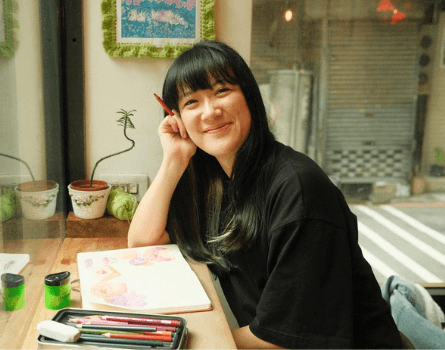Creator Spotlight with Artist Felicia Liang

This week we’d like to introduce you to Taiwanese-American artist Felicia Liang. To see Felicia’s work, visit her website and follow her on Instagram.
What was the inspiration behind becoming an artist? What do you enjoy most about the creative process?
I bought some colored pencils and started drawing for fun to deal with corporate burnout in 2015. I found it very therapeutic just making marks and shading. And then I just started to draw more of my travels, food, and enjoying the entire creative process. I took drawing classes all through middle and high school but focused more on observational and technical skills. As I’ve grown older, I love just taking ideas from my head and putting them onto paper (or iPad!) and telling a story or trying to evoke a feeling through pictures. Drawing has also been a way for me to process my thoughts and emotions and it’s been a wonderful way to build community as well. It’s been a practice that has helped me build both my internal and external worlds.
Can you take us through your creative process? How long does it take? Does everything you produce make money?
My ideas often start with notes from journaling or random thoughts I jot in the Notes app on my phone, no matter where I am. The time it takes to complete a piece will range quite wildly, depending on the project and complexity. My sketchbook spreads are more straightforward and freeing since I’m less precise with them, so they’re done in a few hours. However, unless the piece is time-boxed due to a client’s timeline, my personal work tends to be in a series, so those can take a few days to a few weeks. I often pair my art with some kind of story, so writing often takes up more time than I think too.
Not everything I do produces money, but I’ve gotten paid opportunities with my personal work. I still make it a point to create art just for me, since it not only helps my practice, but builds relationships with people who see it and can potentially lead to paid work.
What do you think is the biggest misconception about your line of work?
Probably how much time I don’t spend on actually illustrating for a project. With client work, there is a lot of back and forth communication to discuss ideas, project scope, and feedback through the reviews. And even for personal work, concepting usually takes me the longest so I spend a lot of time doodling or noodling with my thoughts, but actual execution can be pretty quick once I know what I want to do or convey. That being said, I’m quick with my work through the time I’ve put into practice and should be paid for everything that goes into producing the work, and not just the final design.
When did you first become aware of copyright, and why?
We talked about copyright in an evening illustration course I took in 2016 at School of Visual Arts, and it’s something I make sure I discuss with clients and have in writing before I begin work to ensure the rights are with the right party and that I’m compensated accordingly. I think with social media and sites like Pinterest that are so saturated with artwork, it’s very easy for people to disregard copyright and work can easily be stolen.
Have you experienced copyright infringement and, if so, how has it affected you personally and financially?
I have not experienced it myself, but I know many creators, especially those who make products and merchandise, who’ve had designs stolen either by a larger brand or another company making cheaper versions. Or someone has impersonated them on social media and created a fake account. No matter how it’s done, I can imagine how demoralizing it is. The artist usually gets ripped off in these situations, and it’s damaging to your practice and self. Plus, it’s expensive to hire a lawyer to sort this out, and you may even net out negative at the end of it, so it’s a very deflating process all around. That’s why the new Copyright Claims Board (CCB) is interesting to independent creators who may need it to defend their copyrighted works in an effective, simplified, and cost effective fashion.
What is your biggest copyright-related challenge?
There’s a fear that once you share your work on the internet, it could be stolen by someone else. You want to promote your work in the best light online but have to be aware that it could be stolen once it’s out there. It’s an unfortunate risk that we have to deal with at the moment. But you have to make sure you protect yourself in the long run.
Are you one of our Individual Creator Members? Participate in our Creator Spotlight series! Please email us at cawebsite@copyrightalliance.org. And if you aren’t already a member of the Alliance, you can join today by completing our Individual Creator Members membership form!

